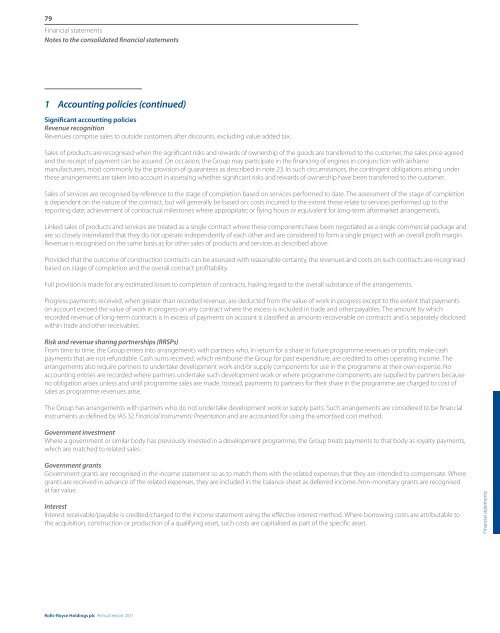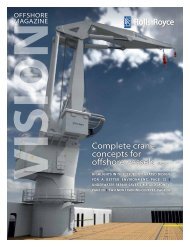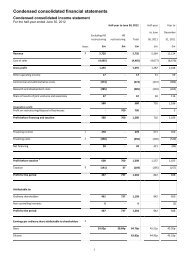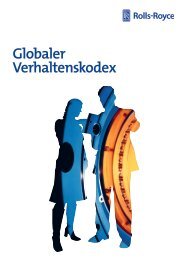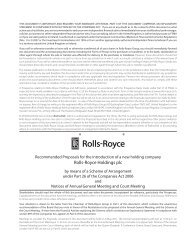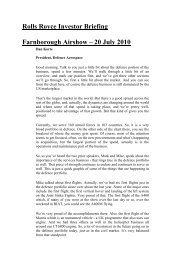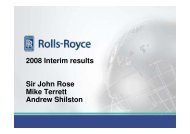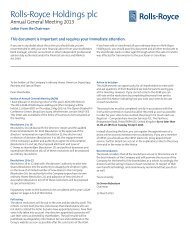Consolidated financial statements - Rolls-Royce
Consolidated financial statements - Rolls-Royce
Consolidated financial statements - Rolls-Royce
Create successful ePaper yourself
Turn your PDF publications into a flip-book with our unique Google optimized e-Paper software.
79<br />
Financial <strong>statements</strong><br />
Notes to the consolidated <strong>financial</strong> <strong>statements</strong><br />
1 Accounting policies (continued)<br />
Significant accounting policies<br />
Revenue recognition<br />
Revenues comprise sales to outside customers after discounts, excluding value added tax.<br />
Sales of products are recognised when the significant risks and rewards of ownership of the goods are transferred to the customer, the sales price agreed<br />
and the receipt of payment can be assured. On occasion, the Group may participate in the financing of engines in conjunction with airframe<br />
manufacturers, most commonly by the provision of guarantees as described in note 23. In such circumstances, the contingent obligations arising under<br />
these arrangements are taken into account in assessing whether significant risks and rewards of ownership have been transferred to the customer.<br />
Sales of services are recognised by reference to the stage of completion based on services performed to date. The assessment of the stage of completion<br />
is dependent on the nature of the contract, but will generally be based on: costs incurred to the extent these relate to services performed up to the<br />
reporting date; achievement of contractual milestones where appropriate; or flying hours or equivalent for long-term aftermarket arrangements.<br />
Linked sales of products and services are treated as a single contract where these components have been negotiated as a single commercial package and<br />
are so closely interrelated that they do not operate independently of each other and are considered to form a single project with an overall profit margin.<br />
Revenue is recognised on the same basis as for other sales of products and services as described above.<br />
Provided that the outcome of construction contracts can be assessed with reasonable certainty, the revenues and costs on such contracts are recognised<br />
based on stage of completion and the overall contract profitability.<br />
Full provision is made for any estimated losses to completion of contracts, having regard to the overall substance of the arrangements.<br />
Progress payments received, when greater than recorded revenue, are deducted from the value of work in progress except to the extent that payments<br />
on account exceed the value of work in progress on any contract where the excess is included in trade and other payables. The amount by which<br />
recorded revenue of long-term contracts is in excess of payments on account is classified as amounts recoverable on contracts and is separately disclosed<br />
within trade and other receivables.<br />
Risk and revenue sharing partnerships (RRSPs)<br />
From time to time, the Group enters into arrangements with partners who, in return for a share in future programme revenues or profits, make cash<br />
payments that are not refundable. Cash sums received, which reimburse the Group for past expenditure, are credited to other operating income. The<br />
arrangements also require partners to undertake development work and/or supply components for use in the programme at their own expense. No<br />
accounting entries are recorded where partners undertake such development work or where programme components are supplied by partners because<br />
no obligation arises unless and until programme sales are made. Instead, payments to partners for their share in the programme are charged to cost of<br />
sales as programme revenues arise.<br />
The Group has arrangements with partners who do not undertake development work or supply parts. Such arrangements are considered to be <strong>financial</strong><br />
instruments as defined by IAS 32 Financial Instruments: Presentation and are accounted for using the amortised cost method.<br />
Government investment<br />
Where a government or similar body has previously invested in a development programme, the Group treats payments to that body as royalty payments,<br />
which are matched to related sales.<br />
Government grants<br />
Government grants are recognised in the income statement so as to match them with the related expenses that they are intended to compensate. Where<br />
grants are received in advance of the related expenses, they are included in the balance sheet as deferred income. Non-monetary grants are recognised<br />
at fair value.<br />
Interest<br />
Interest receivable/payable is credited/charged to the income statement using the effective interest method. Where borrowing costs are attributable to<br />
the acquisition, construction or production of a qualifying asset, such costs are capitalised as part of the specific asset.<br />
Financial <strong>statements</strong><br />
<strong>Rolls</strong>-<strong>Royce</strong> Holdings plc Annual report 2011


